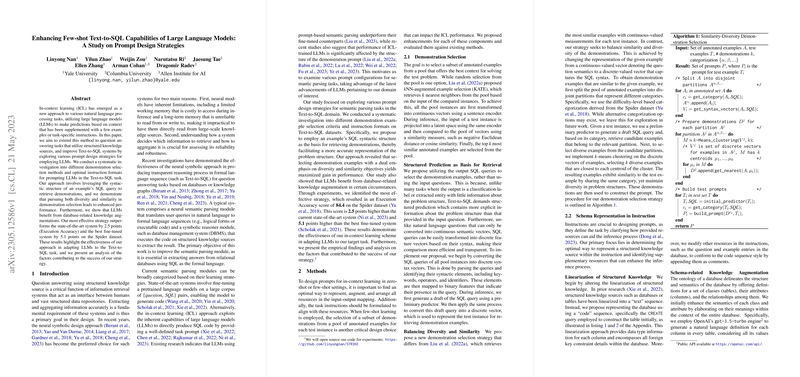Enhancing Few-shot Text-to-SQL Capabilities of LLMs: A Study on Prompt Design Strategies
This paper presents a rigorous exploration into the potential of enhancing Text-to-SQL systems utilizing LLMs through refined prompt design strategies. The focus is on leveraging in-context learning (ICL) techniques, whereby LLMs can generate SQL queries based on a few demonstration examples embedded within task-specific instructions. The paper introduces novel approaches for demonstration selection and schema augmentation to improve execution accuracy on the Spider dataset.
Key Insights and Methodological Details
The researchers conduct a deep dive into different demonstration selection methods, emphasizing a unique approach that bases the selection process on the syntactic structure of SQL queries rather than semantic similarity of the input questions. This strategy comprises balancing diversity and similarity objectives to enhance performance. The most effective strategy outperformed the prevailing state-of-the-art system by 2.5 points and a fine-tuned model by 5.1 points in execution accuracy.
Methodological Innovations
- Demonstration Selection:
- The paper proposes a structured prediction basis using SQL syntax for demonstration retrieval, diverging from the traditional semantic input-based retrieval. This is achieved by translating SQL queries into discrete syntax vectors, allowing for efficient comparison and retrieval.
- A balance between diversity and similarity is sought by categorizing examples based on their complexity and using k-means clustering to ensure diverse coverage of SQL structures.
- Schema Representation and Augmentation:
- Optimal schema representation is explored by converting databases into multiple SQL CREATE statements. This transformation incorporates comprehensive structural details, including data types and constraints.
- Augmentation extends to semantic and structural enhancements, such as adding ontology summaries that describe table relationships, fostering better model understanding of complex queries.
- Integrated Strategy for Text-to-SQL:
- Performance variability due to the number of demonstrations is addressed by employing a majority voting mechanism over multiple model predictions, leading to higher consistency in results.
- The approach shows significant robustness across different dataset variations, including Spider-Syn, Spider-DK, and Spider-Realistic, each presenting distinct challenges like synonym replacements and domain knowledge inclusion.
Implications and Future Work
The implications of this research are substantial for the fields of AI-driven data querying and human-computer interaction. By refining prompt strategies, LLMs demonstrate improved adaptation and efficiency in interpreting structured data sources. The findings underscore the significant role of prompt engineering in enhancing LLM capabilities without extensive task-specific fine-tuning, a critical insight for developing cost-effective and scalable solutions in natural language processing.
Future directions could explore the adaptability of these strategies to other NLP tasks and LLM architectures, building on the foundational concepts detailed herein. Further examination into the combined effect with other sophisticated retrieval techniques, alongside extensions to open-source LLMs for reproducibility, would provide valuable contributions to the field.
In conclusion, this research extends the applicability and efficiency of LLMs in Text-to-SQL interfaces, providing a detailed analysis of prompt design choices that significantly influence model performance. The methodologies proposed enrich the toolkit for researchers and practitioners aiming to leverage LLMs for complex data interaction tasks.
